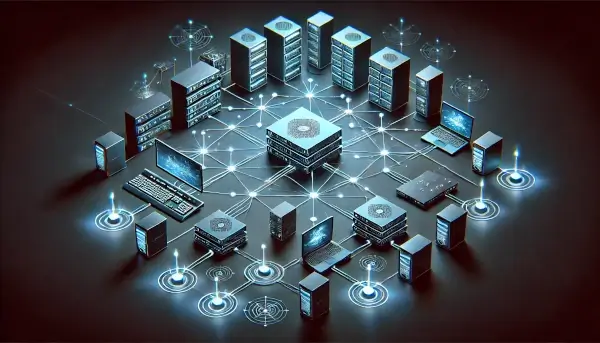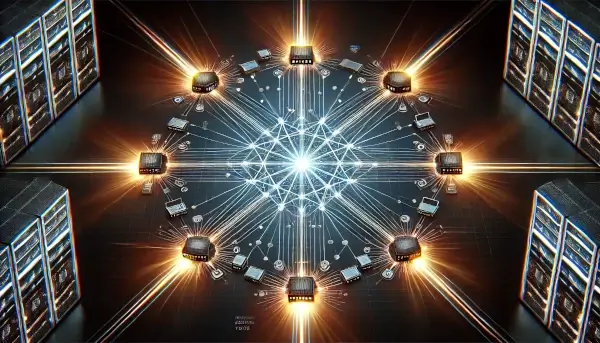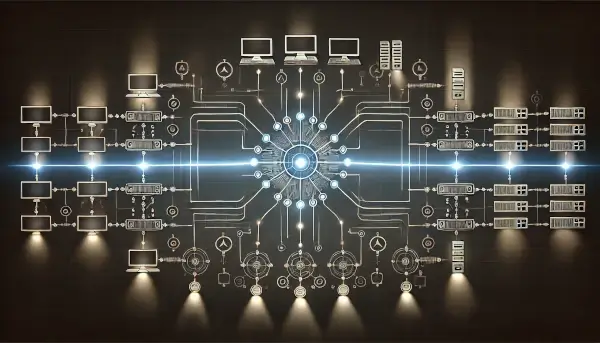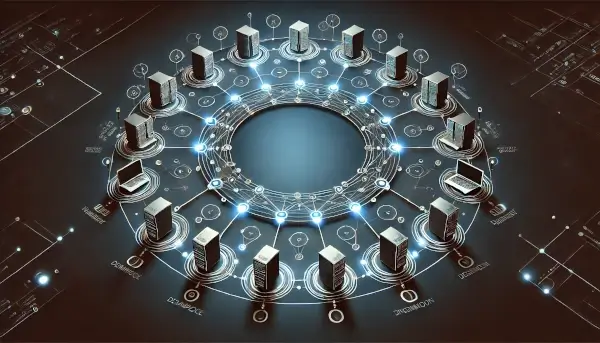
Profitable companies function like well-oiled machines. Sustaining an efficient community is the important thing to attaining this clean operation.
In any case, the best community delivers effectivity and scalability and protects towards cybersecurity threats. That mentioned, constructing a community that meets your distinctive enterprise wants could be difficult.
To take action, it is advisable to decide the proper kind of community topography. However what’s community topography, and what choices are on the market? Let’s dive in.
Desk of Contents:
What is Network Topology?
Types of Network Topology
1. Star Topology
2. Bus Topology
3. Ring Topology
4. Mesh Topology
5. Hybrid Topology
Choosing the Right Network Topology For Your Needs
Conclusion
What’s Community Topology?

Community topology maps out how totally different units and connections are laid out and talk with one another on a community. There are lots of types of topology, however every matches into considered one of two classes:
- Bodily topology: This refers to how units on a community are structured. It contains the place the units are positioned, their bodily distance, and the types of wiring used to attach them.
- Logical topology: This refers to how knowledge is exchanged between units. It focuses on the strategies that units use to speak and the routing of information packets.
By specializing in each bodily and logical topologies, community operators can construct extra environment friendly networks. You possibly can iron out inefficiencies in knowledge transmission and scale back downtime. In the end, this implies higher total community efficiency.
5 Forms of Community Topology
1. Star Topology

In a star topology, totally different units connect with a central hub. From right here, data is exchanged between one system and one other. This topology is without doubt one of the commonest community configurations and is often present in properties or small workplaces with a number of units related to a router.
It is in style for varied causes. Firstly, it is a lower-cost possibility; hub units reminiscent of routers are low cost. Connecting nodes to the hub is equally cheap. Many units have already got inbuilt community playing cards. In any other case, you should purchase and set up an ethernet cable at a low value.
Scalability is one other vital benefit. Routers comprise many various ports, so you may simply join new units. Customers may also improve to the next bandwidth bundle if their transmission necessities improve.
This community’s simplicity will also be an obstacle. If the hub loses connection, there isn’t a backup possibility – all units are disconnected. This makes it a weaker possibility for organizations that want fixed connectivity to facilitate large-scale traffic.
In case your group is contemplating utilizing a star topology, you also needs to contemplate network uptime monitoring in addition to cybersecurity. Central hubs want common firmware updates to make sure sturdy firewalls and defenses.
2. Bus Topology

In a bus topology, all units are related by way of a central cable. When a tool transmits knowledge, it sends a sign to each system on the community. Community operators should set up ‘terminators’ to make sure solely the proper units reply to alerts.
As with the star topology, this technique is comparatively low cost and customarily requires fewer cables. It is also easy to arrange – customers can connect with the central cable straight or use a drop cable.
Sadly, the bus topology may also break simply. A easy cut up within the central cable leaves units reduce off from each other. Equally, If a terminator malfunctions, alerts can turn out to be mirrored and trigger points for all community units. Because of this, it is solely suited to companies that do not need advanced infrastructure and enormous networks.
In case you go for a bus topology, it’s essential to conduct common inspections. Recognizing and correcting errors early is essential to avoiding community disruption. A network monitoring service can routinely detect errors and warn you instantly. Utilizing high-quality cabling additionally helps considerably scale back the danger of injury.
3. Ring Topology

A hoop topology connects every system in a round sample. Requests are despatched to every node one after the other till the proper system is discovered.
With this infrastructure, knowledge flows in a single path, forming a circle. This reduces the danger of packet collisions and removes the necessity for terminators. It is also able to transmitting a lot larger site visitors ranges with minimal impression on efficiency and is comparatively easy to arrange and cheap to develop.
As an example, think about you’re coaching a machine studying program utilizing phrase embeddings. What are word embeddings? They seem to be a approach of assigning phrases and sentences to numbers, serving to AI to make sense of human language.
As you course of the embeddings, you move updates in a hoop sample to make sure all nodes share gradients sequentially. This reduces bandwidth utilization in comparison with a central hub and avoids bottlenecks, permitting you to keep up synchronization in large-scale coaching.
Nonetheless, the draw back is that your entire community will fail if any nodes malfunction. Information can not observe its pre-set sample, making including or eradicating nodes from the community tougher.
To keep away from disruption on a hoop community, hold units up-to-date and be alert for points. You can too go for a second ring community that transmits data in the other way. This may increase effectivity and allow the enterprise to switch larger volumes of information.
4. Mesh Topology

In a mesh topology, each single node is interconnected. Information is transferred utilizing a number of routes all through a community. Generally, this entails a direct hyperlink from one node to a different. At different instances, knowledge will ‘hop’ between nodes.
The main benefit of this strategy is that there isn’t a single level of failure. If a tool malfunctions, knowledge can journey by way of an alternate route and nonetheless attain its vacation spot, making the prospect of a damaged cable or system error a lot much less worrisome.
The mesh topology can be one of many quickest of the totally different topologies mentioned to date. As a substitute of following a pre-set route, it transfers knowledge by way of the quickest path.
Its sturdy and environment friendly nature makes it very best for varied use instances. For instance, it’s possible you’ll be contemplating the benefits of AI virtual assistant choices to your group however are not sure tips on how to present the fixed movement of information AI must perform. A mesh community can facilitate this.
When it comes to disadvantages, a mesh topology entails a whole lot of bodily infrastructure. For every system to be interconnected, you want a number of cables. The acquisition and long-term upkeep of this infrastructure could be costly. This makes it a high-cost possibility that’s doubtlessly out of attain for organizations on a restricted price range.
When selecting this topology, you’ve gotten two choices. You possibly can implement a full mesh, the place all units are interconnected, or you may go for a partial mesh, the place nodes are linked with units they usually interface with. The latter possibility could also be helpful if you wish to hold prices down.
5. Hybrid Topology

Hybrid topology affords one of the best of each worlds, as you may select and mix two topologies. In different phrases, you may incorporate one of the best options from every.
One frequent instance of a hybrid strategy is a star-ring topology. Right here, a number of star topologies encompass a hoop topology. Every star is related to the ring, which serves as a hyperlink to different star topologies. This allows a bi-directional movement of information between star networks.
The star-bus topology is one other instance. Because the title suggests, this technique interlinks a number of star networks to a bus topology by way of a cable. This affords better stability than a typical star community, the place if a hub malfunctions, the community fails. As a result of the hybrid model entails hubs from a number of star networks, performance can proceed.
The apparent draw back of a hybrid topology, although, is that it’s way more advanced, involving extra infrastructure and processes. This usually implies that it additionally comes at a significantly larger value than different community topologies. It is value deploying portfolio management technology to make sure a wise funding.
Moreover, contemplate your group rigorously when planning a hybrid topology. The complexity and scale make managing and sustaining difficult, so that you want a group with the mandatory information and expertise.
Selecting the Proper Community Topology For Your Wants

So, which ring topology must you select? There isn’t any ‘appropriate’ reply. Your selection ought to rely upon the distinctive wants of your small business. When contemplating your choices, bear the next factors in thoughts:
- Community necessities: What would you like your community to attain? What {hardware} and software program can be wanted to fulfill these targets? How far will knowledge must journey to succeed in nodes throughout the community?
- Scalability: Some community topologies are simpler to scale than others. For instance, mesh topologies require a number of extra bodily infrastructure. There could also be higher choices for companies anticipating vital progress within the brief time period.
- Funds: Alongside the acquisition of bodily infrastructure, take a look at the prices of putting in and sustaining your community. Budgeting is a fragile steadiness; detailed networks require larger upfront prices, however cheaper choices could also be costlier in the long term.
- Safety and compliance: Evaluation your group’s safety wants. Do you take care of delicate, personally identifiable data? In that case, there could also be authorized obligations mandating the way you deal with knowledge. Some networks, reminiscent of ring networks, supply built-in redundancy, serving to to safe your knowledge extra successfully.
Increase Community Effectivity with the Finest Topology
A corporation is just as efficient as its community. A sluggish community means sluggish progress and delayed targets. An environment friendly community delivers velocity, improves scalability, and boosts reliability, all of which assist you succeed.
With correct planning, you may construct a community that acts as a robust spine to your group. So, start thinking about your group’s distinctive wants.






